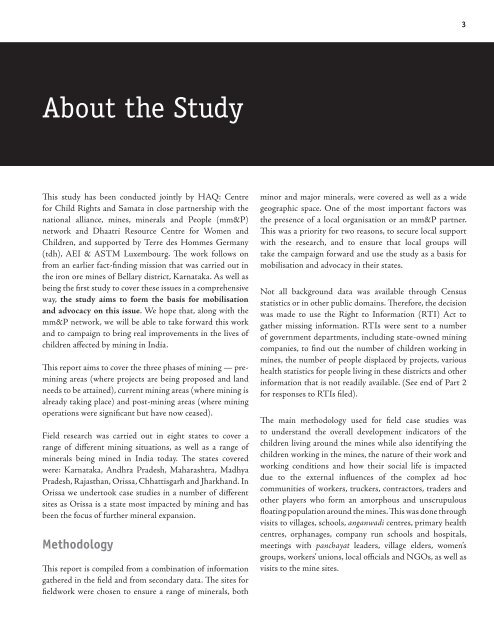Children - Terre des Hommes
Children - Terre des Hommes
Children - Terre des Hommes
Create successful ePaper yourself
Turn your PDF publications into a flip-book with our unique Google optimized e-Paper software.
3<br />
About the Study<br />
This study has been conducted jointly by HAQ: Centre<br />
for Child Rights and Samata in close partnership with the<br />
national alliance, mines, minerals and People (mm&P)<br />
network and Dhaatri Resource Centre for Women and<br />
<strong>Children</strong>, and supported by <strong>Terre</strong> <strong>des</strong> <strong>Hommes</strong> Germany<br />
(tdh), AEI & ASTM Luxembourg. The work follows on<br />
from an earlier fact-finding mission that was carried out in<br />
the iron ore mines of Bellary district, Karnataka. As well as<br />
being the first study to cover these issues in a comprehensive<br />
way, the study aims to form the basis for mobilisation<br />
and advocacy on this issue. We hope that, along with the<br />
mm&P network, we will be able to take forward this work<br />
and to campaign to bring real improvements in the lives of<br />
children affected by mining in India.<br />
This report aims to cover the three phases of mining — premining<br />
areas (where projects are being proposed and land<br />
needs to be attained), current mining areas (where mining is<br />
already taking place) and post-mining areas (where mining<br />
operations were significant but have now ceased).<br />
Field research was carried out in eight states to cover a<br />
range of different mining situations, as well as a range of<br />
minerals being mined in India today. The states covered<br />
were: Karnataka, Andhra Pra<strong>des</strong>h, Maharashtra, Madhya<br />
Pra<strong>des</strong>h, Rajasthan, Orissa, Chhattisgarh and Jharkhand. In<br />
Orissa we undertook case studies in a number of different<br />
sites as Orissa is a state most impacted by mining and has<br />
been the focus of further mineral expansion.<br />
Methodology<br />
This report is compiled from a combination of information<br />
gathered in the field and from secondary data. The sites for<br />
fieldwork were chosen to ensure a range of minerals, both<br />
minor and major minerals, were covered as well as a wide<br />
geographic space. One of the most important factors was<br />
the presence of a local organisation or an mm&P partner.<br />
This was a priority for two reasons, to secure local support<br />
with the research, and to ensure that local groups will<br />
take the campaign forward and use the study as a basis for<br />
mobilisation and advocacy in their states.<br />
Not all background data was available through Census<br />
statistics or in other public domains. Therefore, the decision<br />
was made to use the Right to Information (RTI) Act to<br />
gather missing information. RTIs were sent to a number<br />
of government departments, including state-owned mining<br />
companies, to find out the number of children working in<br />
mines, the number of people displaced by projects, various<br />
health statistics for people living in these districts and other<br />
information that is not readily available. (See end of Part 2<br />
for responses to RTIs filed).<br />
The main methodology used for field case studies was<br />
to understand the overall development indicators of the<br />
children living around the mines while also identifying the<br />
children working in the mines, the nature of their work and<br />
working conditions and how their social life is impacted<br />
due to the external influences of the complex ad hoc<br />
communities of workers, truckers, contractors, traders and<br />
other players who form an amorphous and unscrupulous<br />
floating population around the mines. This was done through<br />
visits to villages, schools, anganwadi centres, primary health<br />
centres, orphanages, company run schools and hospitals,<br />
meetings with panchayat leaders, village elders, women’s<br />
groups, workers’ unions, local officials and NGOs, as well as<br />
visits to the mine sites.






